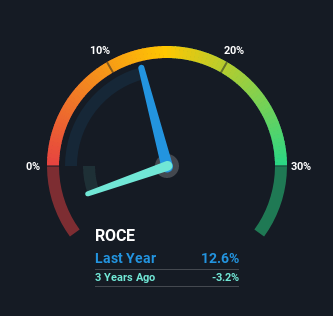Capital Allocation Trends At Neochim AD (BUL:NEOH) Aren't Ideal
Ignoring the stock price of a company, what are the underlying trends that tell us a business is past the growth phase? More often than not, we'll see a declining return on capital employed (ROCE) and a declining amount of capital employed. This indicates the company is producing less profit from its investments and its total assets are decreasing. And from a first read, things don't look too good at Neochim AD (BUL:NEOH), so let's see why.
Return On Capital Employed (ROCE): What is it?
For those who don't know, ROCE is a measure of a company's yearly pre-tax profit (its return), relative to the capital employed in the business. Analysts use this formula to calculate it for Neochim AD:
Return on Capital Employed = Earnings Before Interest and Tax (EBIT) ÷ (Total Assets - Current Liabilities)
0.13 = лв15m ÷ (лв151m - лв28m) (Based on the trailing twelve months to June 2021).
Thus, Neochim AD has an ROCE of 13%. That's a relatively normal return on capital, and it's around the 11% generated by the Chemicals industry.
See our latest analysis for Neochim AD

Historical performance is a great place to start when researching a stock so above you can see the gauge for Neochim AD's ROCE against it's prior returns. If you'd like to look at how Neochim AD has performed in the past in other metrics, you can view this free graph of past earnings, revenue and cash flow.
So How Is Neochim AD's ROCE Trending?
We are a bit worried about the trend of returns on capital at Neochim AD. About five years ago, returns on capital were 23%, however they're now substantially lower than that as we saw above. Meanwhile, capital employed in the business has stayed roughly the flat over the period. This combination can be indicative of a mature business that still has areas to deploy capital, but the returns received aren't as high due potentially to new competition or smaller margins. So because these trends aren't typically conducive to creating a multi-bagger, we wouldn't hold our breath on Neochim AD becoming one if things continue as they have.
What We Can Learn From Neochim AD's ROCE
In the end, the trend of lower returns on the same amount of capital isn't typically an indication that we're looking at a growth stock. Long term shareholders who've owned the stock over the last five years have experienced a 60% depreciation in their investment, so it appears the market might not like these trends either. Unless there is a shift to a more positive trajectory in these metrics, we would look elsewhere.
If you'd like to know more about Neochim AD, we've spotted 4 warning signs, and 1 of them is a bit unpleasant.
If you want to search for solid companies with great earnings, check out this free list of companies with good balance sheets and impressive returns on equity.
Valuation is complex, but we're here to simplify it.
Discover if Neochim AD might be undervalued or overvalued with our detailed analysis, featuring fair value estimates, potential risks, dividends, insider trades, and its financial condition.
Access Free AnalysisThis article by Simply Wall St is general in nature. We provide commentary based on historical data and analyst forecasts only using an unbiased methodology and our articles are not intended to be financial advice. It does not constitute a recommendation to buy or sell any stock, and does not take account of your objectives, or your financial situation. We aim to bring you long-term focused analysis driven by fundamental data. Note that our analysis may not factor in the latest price-sensitive company announcements or qualitative material. Simply Wall St has no position in any stocks mentioned.
Have feedback on this article? Concerned about the content? Get in touch with us directly. Alternatively, email editorial-team (at) simplywallst.com.
About BUL:NEOH
Neochim AD
Produces and trades in fertilizers, and inorganic and organic chemical products in Bulgaria and internationally.
Flawless balance sheet and good value.
Market Insights
Community Narratives



